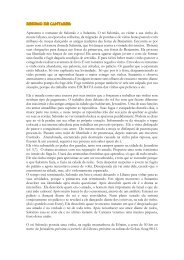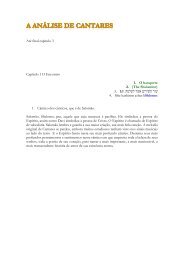The History of Doing
You also want an ePaper? Increase the reach of your titles
YUMPU automatically turns print PDFs into web optimized ePapers that Google loves.
<strong>The</strong> <strong>History</strong> <strong>of</strong> <strong>Doing</strong><br />
An Illustrated Account <strong>of</strong> Movements<br />
for Women's Rights and Feminism in India 1800-1990<br />
RADH A KUMAR<br />
koli for women<br />
1993
<strong>The</strong> <strong>History</strong> <strong>of</strong> <strong>Doing</strong>: An IJJmtmted Account <strong>of</strong> Movements<br />
for Women's in 1800-1990<br />
was first published by<br />
Safi for Women.<br />
A 36 Gubnohar Park<br />
NewDeIMH§049<br />
© Radha Kumar 1993<br />
Photographs as credited at end<br />
All fights r&erved<br />
81-85107-15-0<br />
Typesetting by IPP Catalog Publications Pvt Ltd,, New Delhi<br />
and printed at Indraprastha Press (CBT), New Delhi
11. <strong>The</strong> Agitation Against Sati 1987-88<br />
Protesting against Roop Kanwar's<br />
immolation, Delhi 1987
THE AGITATION AGAINST SATI 173<br />
Young widow with her husband's<br />
dead body, just before immolation, private<br />
family album, Sitapur, date not known<br />
In September 1987, an incident <strong>of</strong> sati (widow immolation)<br />
in a village in Rajasthan sparked <strong>of</strong>f a campaign<br />
which gave rise to a furious debate which spanned not<br />
only the rights and wrongs <strong>of</strong> Hindu women, but questions<br />
<strong>of</strong> religious identity, communal autonomy and the<br />
role <strong>of</strong> the law and the State in a society as complex and<br />
as diverse as India's. While some <strong>of</strong> the arguments used<br />
in the debate were not new, its form and structure were<br />
illuminating, as much for what they obscured as for what<br />
they revealed <strong>of</strong> the intricate web <strong>of</strong> social change in<br />
India (including the current state <strong>of</strong> the feminist<br />
movement).<br />
In the course <strong>of</strong> the debate a series <strong>of</strong> binary oppositions<br />
were invoked, between rural and urban, tradition<br />
and modernity, complementarity and sameness, the<br />
state and religious communities, spiritualism and materialism,<br />
and so on. <strong>The</strong> invocation <strong>of</strong> these oppositions<br />
had the effect <strong>of</strong> presenting either side (for and against<br />
sati) as homogeneous, so that the former were described<br />
as representing rural, traditional communities who were<br />
struggling to preserve themselves from the homogenizing<br />
tendencies <strong>of</strong> the Indian nation-state, while the latter<br />
were described as representing elite, urban, modern<br />
sections <strong>of</strong> society, who were pressing the state to intervene<br />
in communities they bore no relation to, and were<br />
thus supporting and encouraging the nation-state to<br />
extend its sphere <strong>of</strong> control over civil society.<br />
Versions <strong>of</strong> this argument began to be advanced<br />
within a couple <strong>of</strong> weeks <strong>of</strong> the incident <strong>of</strong> sati, and<br />
almost immediately after the campaign against it began.<br />
While the argument itself was earlier used by the supporters<br />
<strong>of</strong> the Muslim Women's Bill in 1986-87, the way<br />
in which it appeared in the debate over sati showed how<br />
greatly the argument had developed. For example, in<br />
the earlier agitation the argument was advanced mainly<br />
by pro-Bill leaders, but in the latter it was advanced both<br />
by pro-sati leaders and by a group <strong>of</strong> 'outsiders' (in the<br />
form <strong>of</strong> a series <strong>of</strong> newspaper articles). <strong>The</strong>se appeared<br />
first in the Delhi-based Hindi and English language<br />
national dailies, Jan Satta, ('Banwari' 29.9.87), Indian<br />
Express (Ashis Nandy, 5.10.87 and Statesman (Patrick D<br />
Harrigan, 5.11.87), and all three writers, in their various<br />
Immolation, private family album,<br />
Sitapur, date not known<br />
Painted chariot celebrating widow<br />
immolation, Rajasthan, 1987
174 THE HISTORY OF DOING<br />
ways, lent a kind <strong>of</strong> outsider respectability to the<br />
argument so that it also began to be advocated by<br />
considerable numbers <strong>of</strong> those very urban, modern<br />
sections <strong>of</strong> society which it sought to attack.<br />
Perhaps the most striking point about the articles by<br />
'Banwari', Ashis Nandy and Patrick Harrigan was that all<br />
three propounded their arguments in the form <strong>of</strong> a<br />
polemic against the Indian feminist movement, accusing<br />
Indian feminists <strong>of</strong> being agents <strong>of</strong> modernity who<br />
were attempting to impose crass market-dominated<br />
views <strong>of</strong> equality and liberty on a society which once gave<br />
the noble, the self-sacrificing and the spiritual the<br />
respect they deserve, but which is now being rapidly<br />
destroyed by the essentially selfish forces <strong>of</strong> the market.<br />
All three, moreover, defined these crass market-dominated<br />
views <strong>of</strong> equality and liberty as being drawn from<br />
the West, so Indian feminists stood accused <strong>of</strong> being<br />
Westernists, colonialists, cultural imperialists, and—<br />
indirectly—supporters <strong>of</strong> capitalist ideology.<br />
Though Indian feminists had suffered a series <strong>of</strong><br />
attacks in the eighties, this was to date the most major <strong>of</strong><br />
them, for not only did it appear to be concerted, its<br />
timing was such that it appeared to lend legitimacy both<br />
to an ideology which claimed that the finest act a woman<br />
could perform was to die with her husband, and to a<br />
specific incident <strong>of</strong> sad which was beginning to seem<br />
more and more like an incident <strong>of</strong> murder. Outrageous<br />
as the accusations against themselves seemed to Indian<br />
feminists, who had shown themselves to be anti-imperialist<br />
and anti-capitalist in a number <strong>of</strong> ways—and many<br />
<strong>of</strong> whom had, ironically enough, themselves launched a<br />
critique <strong>of</strong> 'Western feminist' goals and methods many<br />
years prior to this attack—what made it worse was the<br />
fact that not one <strong>of</strong> these writers addressed themselves<br />
to the question <strong>of</strong> what had happened, or was happening,<br />
in Deorala where the sati had taken place, nor did<br />
any <strong>of</strong> them ask under what conditions Roop Kanwar<br />
had lived, or under what conditions she had died.<br />
September 1987 was not the first time that Indian<br />
feminists encountered the problem <strong>of</strong> sati. <strong>The</strong> first<br />
encounter in Delhi was in 1983, when a campaign to<br />
further popularize the ideology <strong>of</strong> sati was launched by<br />
a Marwari-funded organization known as the Rani Sati<br />
Sarva Sangh. <strong>The</strong> RSSS, which already ran several sati<br />
temples in Rajasthan and Delhi, had got the then Government<br />
to grant them a plot <strong>of</strong> land in Delhi to build<br />
yet another sati temple, and had decided to celebrate<br />
diis grant by leading a procession <strong>of</strong> men and women to<br />
die temple. Delhi feminists heard <strong>of</strong> this plan, and<br />
decided to hold a counter-demonstration along the<br />
route <strong>of</strong> the procession, which they did with signal<br />
failure, partly because they had had no time to mobilize,<br />
and thus found themselves outnumbered, and partly<br />
because this was the first time that they had had to<br />
confront a group <strong>of</strong> women in a hostile situation; this<br />
was in itself so distressing that it took the heart out <strong>of</strong><br />
their demonstration. Most distressing <strong>of</strong> all, however,<br />
was the way in which the processionists appropriated the<br />
language <strong>of</strong> rights, stating that they should have the<br />
right, as Hindus and as women, to commit, worship and<br />
propagate sati. At the same time, they also appropriated<br />
feminist slogans on women's militancy, for example,<br />
'hum Bharat ki nan hain, phool nahin, chingari hairi (we,<br />
the women <strong>of</strong> India, are not flowers but fiery sparks).<br />
<strong>The</strong> feminists who attended that demonstration experienced,<br />
therefore, the humiliating sense <strong>of</strong> loss which<br />
accompanies the discovery that your own words can so<br />
readily be snatched and turned against you to serve an<br />
antithetical cause. 1 This experience led to two different<br />
reactions: one, the determination to research into the<br />
existence <strong>of</strong> sati, sati temples and the proponents <strong>of</strong><br />
'sati-dharma' in India; the other, to find non-confrontational<br />
ways in which to undermine the ideology <strong>of</strong> sati.<br />
Both, however, emphasized the need to study, comprehend<br />
and deal with the traditional.<br />
Whether for these reasons, or because no further<br />
public campaigns in support <strong>of</strong> sati occurred, the issue<br />
faded out until Roop Kanwar's death in 1987. Given that<br />
there has been, on an average, something like one sati<br />
a year in India, why did this incident arouse such frenzy<br />
when others had not? Only four months earlier, the<br />
police had prevented a woman called Banwari from<br />
committing sati, and had dispersed the twenty thousand<br />
odd people who had assembled at Bagda village in Pali<br />
district to witness the event.2 Two years earlier, in March<br />
1985, the police had prevented another sati in Jaipur<br />
district and had used both tear gas and lathicharges to<br />
disperse the thirty thousand odd people who had collected<br />
at the proposed site.3 In neither incident did<br />
police intervention result in agitations against them. Yet<br />
Roop Kanwar's death, which no-one prevented, led to a<br />
massive agitation both for and against sati. It was only as<br />
a campaign around me issue developed that it became<br />
evident that this particular sati was indeed different from<br />
most <strong>of</strong> the others. In contrast to some <strong>of</strong> the other areas<br />
in which sati had been attempted, Deorala was a relatively<br />
highly developed village. <strong>The</strong> family, while not<br />
perhaps wealthy, were well-to-do. Roop Kanwar's fatherin-law<br />
was headmaster <strong>of</strong> a district school, while she<br />
herself was a graduate. A Rajput family, they had links<br />
with influential Rajputs and mainstream state-level<br />
politicians.<br />
Roop Kanwar had only been married a short while<br />
before her husband died. Her dowry included some<br />
thirty tolas <strong>of</strong> gold. Her husband suffered from mental<br />
disorder and they had spent only around six months<br />
together. When, after his death, it was decided that Roop<br />
Kanwar would 'become' sati, the impending event was<br />
announced in advance, because sati is always a public<br />
spectacle. Yet her family were not informed. Evidence
THE AGITATION AGAINST SATI 175<br />
which trickled out pointed to murder: some <strong>of</strong> her<br />
neighbours said that she had run away and tried to hide<br />
in a barn before the ceremony, but was dragged out,<br />
pumped full <strong>of</strong> drugs, dressed in her bridal finery and<br />
put on the pyre, with logs and coconuts heaped upon<br />
her. <strong>The</strong> pyre itself was lit by her brother-in-law, a<br />
minor.4<br />
Hearing that the press was on its way, the organizers<br />
<strong>of</strong> her sati brought forward the 'event'. When the press<br />
arrived at Deorala, they were abused and manhandled<br />
by self-appointed protectors <strong>of</strong> the Sati-sthal (site <strong>of</strong> sati).<br />
In other words, it was evident that the planners <strong>of</strong> the<br />
sati saw themselves as being in a state <strong>of</strong> siege before any<br />
questions <strong>of</strong> a battle had even arisen. Could it be that<br />
they themselves chalked out the battles: were they in fact<br />
looking for a battle? Some credence was lent to this view<br />
by the response <strong>of</strong> the government,<br />
Reports indicated that the local authorities knew <strong>of</strong><br />
the planned sad, yet their only action was to despatch a<br />
police jeep which had overturned on its way to the site.<br />
Following this debacle, three more days elapsed before<br />
a government representative visited Deorala.5 Even<br />
more shocking was their general attitude, consisting as<br />
it were not <strong>of</strong> the usual tactic <strong>of</strong> slothful procrastination<br />
which government uses when it wishes to avoid an issue,<br />
but <strong>of</strong> a kind <strong>of</strong> sullen paralysis in which over two weeks<br />
went by before any statement was made by government<br />
spokesmen, either in the state or at the centre. No<br />
attempts were made to arrest anybody, despite mounting<br />
evidence <strong>of</strong> coercion and mounting public pressure.<br />
<strong>The</strong> doctor who drugged Roop Kanwar meanwhile disappeared.<br />
Immediately after the immolation, the site became a<br />
popular pilgrimage spot, and, as in Jhunjhunu, a number<br />
<strong>of</strong> stalls sprang up, selling auspicious <strong>of</strong>ferings, mementoes<br />
(such as a trick photograph <strong>of</strong> Roop Kanwar<br />
sitting on the pyre with her husband's head on her lap<br />
and a blissful smile on her face, while the flames spurted<br />
about her,) and audio cassettes <strong>of</strong> devotional songs. Her<br />
father-in-law, prominent men from the village, and<br />
members <strong>of</strong> a newly formed organization, the SatiDharm<br />
Raksha Samiti, (organization for the defence <strong>of</strong> the religio-ethical<br />
ideal <strong>of</strong> sati), together formed a Trust along<br />
the lines <strong>of</strong> the Rani Sati Sarva Sangha Trust, to run the<br />
site and collect donations. What passes for modern<br />
technology in our country was used by the Trust to<br />
organize worship at the site: parking lots were arranged<br />
and traffic controllers appointed; a control tower was set<br />
up near the site and a fairly elaborate system <strong>of</strong> loudspeakers<br />
was strung around the area, through which<br />
instructions from the control tower were transmitted to<br />
pilgrims, Trust functionaries, et al. <strong>The</strong> mahajans took<br />
the responsibility <strong>of</strong> organizing stalls selling food, and<br />
accommodation for the pilgrims (these are their areas<br />
<strong>of</strong> expertise). Though no information was collected as<br />
In 1982 fundamentalist men and women in Delhi took<br />
out a procession in support <strong>of</strong> sad. This picture shows<br />
a small section <strong>of</strong> this march, with the men in the<br />
background for protection.<br />
to how much money was made by them, or by the<br />
stall-owners, it was reported that within some three<br />
weeks the Trust itself had collected around Rs 50 lakhs.6<br />
Sati is big business. Despite demands from feminists and<br />
social reformers, this money was not impounded.<br />
While certain aspects <strong>of</strong> this business side <strong>of</strong> the sati<br />
are neither new nor particularly modern, such as the site<br />
becoming a pilgrimage spot and stalls springing up all<br />
around it to sell objects to the devout, the scale <strong>of</strong> it and<br />
the technologizing <strong>of</strong> the pilgrimage event is obviously<br />
modern, Kumkum Sangari has pointed out how the new<br />
palatial sati temples replay the act <strong>of</strong> sati through models<br />
<strong>of</strong> the woman, the dead man and the burning pyre; she<br />
shows, further, that the 'worship' <strong>of</strong> sati-dharm or sati is<br />
produced and controlled through commodification, for<br />
next to the new temples there are sad-memorial stones<br />
which lie neglected and unworshipped. 7<br />
In other words, far from the feminists imposing market-dominated<br />
notions <strong>of</strong> equality on an anti-materialist<br />
society which celebrated self-sacrifice, the event revealed<br />
the gruesome materialism <strong>of</strong> a society which permitted<br />
the production <strong>of</strong> 'sacrifice' for pr<strong>of</strong>it.<br />
Further, and in many ways more dismayingly, feminists<br />
discovered through this campaign the complex<br />
relations through which issues concerning women can<br />
be used to stake claims to power. Sudesh Vaid has shown<br />
how the 'tradition' <strong>of</strong> sati and sati-dharma was created<br />
in Shekhavati region (where Deorala is located) after<br />
Independence, largely to regain lost authority. (Interestingly,<br />
some three quarters <strong>of</strong> recorded satis since 1947<br />
have been in this region). Originally comprising small<br />
princely states and chiefdoms, the area had supported<br />
the outlawing <strong>of</strong> sati in 1846. After Independence, with<br />
the abolition <strong>of</strong> princely states, and the further abolition<br />
<strong>of</strong> the zamindari and jagirdari systems <strong>of</strong> land relations,
176 THE HISTORY OF DOING<br />
Picketing pro-sati demonstration, Delhi, 1982<br />
Demonstrating against Roop Kanwar's<br />
immolation, Delhi, 1987<br />
Joint Action Forum Against Sati<br />
(15 organizations) Delhi, 1987<br />
together with land reforms, the Kshatriyas and banias<br />
lost some <strong>of</strong> the power and privilege they had held.<br />
Anti-land reform agitations were launched first by ex-rulers<br />
and large land-owners under a newly formed organization,<br />
the Kshatriya Mahasabha. When they were<br />
successful in reinstating the Jagirdari system, small landowners<br />
followed by launching a similar agitation and<br />
forming an organization called the Bhooswami Sangh.<br />
Both organizations invoked a chivalric 'Rajput' tradition<br />
in which men defended die Hindu tradition on<br />
battlefields by killing and being killed, while women<br />
defended it at home by killing themselves (jauhar and<br />
sati). Rajput identity was, further, fused with a militant<br />
neo-fundamentalist Hinduism, with demonstrations <strong>of</strong><br />
'tens <strong>of</strong> thousands <strong>of</strong> lathi-weilding saffron-clad Rajputs'.<br />
Sati now began to be projected as exemplifying<br />
the true Rajput identity: the first post-Independence sati<br />
in this area was in 1954, and at the same time an old<br />
sati-memorial, Jhunjhunu, was rebuilt and expanded.<br />
Annual 'sati melas' now began to be held.8<br />
This glorification <strong>of</strong> sati was funded and supported by<br />
mahajans, in particular, marwaris. It was they who rediscovered<br />
and rebuilt old sati shrines, and founded the<br />
Rani Sati Sarva Sangh, which now runs 105 sati temples<br />
all over India. In a sense therefore the old relations <strong>of</strong><br />
mutual advantage between Rajputs and mahajans<br />
gained a new fillip through sati.<br />
<strong>The</strong> parallels between the 1950s use <strong>of</strong> sati to assert<br />
an identity and the event <strong>of</strong> 1987 are fascinating. Hard<br />
on the heels <strong>of</strong> Roop Kanwar's death, a Sati Dharma<br />
Raksha Samiti was formed in Jaipur city, whose leaders<br />
were urban men, many <strong>of</strong> them pr<strong>of</strong>essionals or businessmen<br />
from land-owning families, whose sphere <strong>of</strong><br />
influence extended over both rural and urban areas.<br />
Together with the Deorala Trust, this Samiti announced<br />
that a Chunri mahotsav (veil festival) would be held some<br />
ten days after Roop Kanwar's death. A ritual cremation<br />
<strong>of</strong> the veil after the woman's death is, it seems, traditional<br />
in the area, but never before had it been called a<br />
mahotsav or festival.<br />
Feminists in Jaipur petitioned the High Court to forbid<br />
the ceremony, and the High Court instructed the<br />
state government to prevent it from taking place.<br />
Though the Attorney-General announced that it would<br />
be stopped, the sole action <strong>of</strong> the state government was<br />
to stop vehicles at a certain point, but to allow people to<br />
disembark and join the procession. Five hundred policemen<br />
were posted along the route, clothed 'in civilian<br />
dress so that they would not <strong>of</strong>fend the crowd'. 9 <strong>The</strong><br />
mahotsav was performed, and from an act <strong>of</strong> mourning<br />
it was transformed into a show <strong>of</strong> strength, a victory<br />
celebration, with the male marchers, traditionally<br />
dressed, waving their fists al<strong>of</strong>t in triumph and shouting<br />
slogans. <strong>The</strong> site itself was transformed into a political<br />
rallying ground: a highly charged state-<strong>of</strong>-siege
THE AGITATION AGAINST SATI 177<br />
atmosphere was created by sword wielding youth who<br />
surrounded the sati-sthal, and instead <strong>of</strong> devotional<br />
songs they shouted slogans which were clearly modelled<br />
on mainstream political slogans. Madhu Kishwar and<br />
Ruth Vanita have shown how these slogans fell into three<br />
major groups:<br />
(1) Slogans based on leader glorification, such as 'Sati<br />
ho to kaisi ho? Roop Kanwar jaisi ho', which is based on<br />
'Desh ka neta kaisa ho? Rajiv Gandhi (or x) jaisa ho'.<br />
(2) Victory chants, such as, 'Ek do teen char, sati mala ki<br />
jaijai kar'.<br />
(3) Slogans drawn from Hindu communalist movements,<br />
such as 'Desh dharam ka nata hai, sati hamari mata<br />
hai ' which is based on 'Desh dharam ka nata hai, gai hamari<br />
mata hai.' 10<br />
Even though several laws exist under which the ideologues<br />
and pr<strong>of</strong>iteers <strong>of</strong> sati could have been punished,<br />
the state government took no action, largely because the<br />
issue had become one <strong>of</strong> Rajput community identity,<br />
and the Rajputs are an influential community. In fact,<br />
several state level politicians immediately rushed down<br />
to pay their respects at the site, among whom were the<br />
state Janata Party Chief, a Bharatiya Janata Party<br />
'You are possessed by the truth, you are<br />
possessed by the truth, Delhi, 1987<br />
A group <strong>of</strong> schoolchildren at the<br />
anti-sati march in Delhi. Many schools gave<br />
their students a day <strong>of</strong>f to participate in the march.<br />
member <strong>of</strong> the Rajasthan Legislative Assembly and a Lok<br />
Dal member, the acting president <strong>of</strong> the Rajput Sabha,<br />
and an ex-member <strong>of</strong> the Legislative Assembly from the<br />
Congress-I." So almost all the major centre to right wing<br />
political parties went to the site, not to enquire into what<br />
had happened but to stake their own claim to 'tradition',<br />
and via this to the Rajput vote. Behind this there also<br />
lurked the spectre <strong>of</strong> the 'Hindu vote', and behind both<br />
were questions <strong>of</strong> majority-minority politics, caste and<br />
communal representation.<br />
<strong>The</strong> process through which this happened is a revealing<br />
one, for it sheds light on communal formations in<br />
India and shows how issues <strong>of</strong> gender can become central<br />
to these. At the policy-maker and intelligentsia levels<br />
the major argument <strong>of</strong> the pro-sati camp was that if the<br />
state represented the people, then the Rajputs were a<br />
people among whom sati was an ideal and a tradition<br />
and as such it should be recognized and legitimized. On<br />
the ground, however, it was argued that a refusal to<br />
legitimize sati was a deliberate attempt to marginalize<br />
the Rajputs. <strong>The</strong> opponents <strong>of</strong> sati, for example, were<br />
presented as people who were using the issue as a cover<br />
to attack the Rajputs per se. <strong>The</strong> widespread appeal <strong>of</strong><br />
this argument became clear to feminists who were active
178 THE HISTORY OF DOING<br />
All India Democradc Women's Association activist, Brinda Karat at a demonstration against<br />
Roop Kanwar's immolation, Delhi 1987<br />
in the campaign against sati, fora majority <strong>of</strong> the Rajputs<br />
whom we met focussed on this point rather than on a<br />
defence <strong>of</strong> sati itself. Almost without exception, they<br />
asked why such an issue was being made <strong>of</strong> sati and,<br />
almost without exception, they saw the campaign as<br />
being directed against the Rajputs per se.<br />
Both arguments were taken a step further by two other<br />
groups. <strong>The</strong> first, head priests <strong>of</strong> the major Hindu temples<br />
in such centres as Benares and Puri, issued statements<br />
that sad represented one <strong>of</strong> the most noble<br />
elements not only <strong>of</strong> Rajput culture, but <strong>of</strong> Hinduism,<br />
and claimed scriptural sanction for this view. While<br />
re-iterating the need to legitimize sad, the main thrust<br />
<strong>of</strong> their argument was that such issues came under their<br />
purview and not that <strong>of</strong> the state. At the same time they<br />
also raised the bogey <strong>of</strong> 'Hindusim in danger' from the<br />
opponents <strong>of</strong> sati.<br />
<strong>The</strong> second group consisted <strong>of</strong> a section <strong>of</strong> extreme<br />
right Hindu nationalists, spearheaded by the Shiv Sena.<br />
<strong>The</strong> Shiv Sena was active in the pro-sati agitation, organizing<br />
demonstrations on the Hinduism-in-danger line,<br />
and arguing that the State is particularly biased against<br />
the Hindus, for it is willing to accede to the demands <strong>of</strong><br />
minority communides for representation, but is unwilling<br />
to do the same for the majority. (<strong>The</strong> particular point <strong>of</strong><br />
reference here was to the Muslim Women's Bill).<br />
In a way the definition <strong>of</strong> the democradc state in India<br />
has always been deeply ambivalent on the relationship<br />
between secularism and religious representation. What<br />
is new really is the extent to which the two are today<br />
converging, so that secularism has become synonymous<br />
with providing 'fair' representation to different religious<br />
communities, which are defined in opposition to each<br />
other. Thus the 'true' representatives <strong>of</strong> different religious<br />
communities are held to be their fundamentalist<br />
leaders, rather than, say, the reformers within their<br />
ranks. Mobilization on communal grounds is thus an<br />
extremely effective political tool, both to gain political<br />
space and State recognition, and to create politicalelectoral<br />
bases. An index <strong>of</strong> the mainstream communalization<br />
<strong>of</strong> politics and the constituency <strong>of</strong> women as a<br />
communal 'sign' is the rise <strong>of</strong> two centrist Janata Party
THE AGITATION AGAINST SATI 179<br />
College girls marching against sati, Delhi 1987<br />
politicians, Syed Shahabhuddin and Kalyan Singh Kalvi,<br />
both <strong>of</strong> whom shot into prominence as communal fundamentalist<br />
leaders, the former via the Muslim Women's<br />
Bill agitation, and the latter via the pro-sati agitation.<br />
Shahabuddin today heads his own political party, while<br />
Kalvi is an elected representative <strong>of</strong> the Janata Dal.<br />
Questions <strong>of</strong> representation, politics and the state<br />
arose in a new way for feminists in 1987-88. Religious<br />
fundamentalism, as we find all over the world, not only<br />
rationalizes the sexual oppression <strong>of</strong> women, but also<br />
mobilizes them in support <strong>of</strong> their own oppression. <strong>The</strong><br />
pro-sati agitationists mobilized considerable sections <strong>of</strong><br />
women in their own support, both on a castiest (Rajput)<br />
and on a religious (Hindu) platform. That is to say, they<br />
mobilized women who would seem to be direcdy affected<br />
by their demands. This allowed them to claim that<br />
they represented the 'true' desires <strong>of</strong> Hindu women,<br />
and to accuse the feminists <strong>of</strong> being unrepresentative.<br />
So the feminists were placed in the anomalous position<br />
<strong>of</strong> appearing to speak in the interests <strong>of</strong> women whom<br />
they could not claim to represent and who defined their<br />
interests differently.<br />
<strong>The</strong> tradition versus modernity argument entered this<br />
context in such a way as to further isolate the feminists.<br />
<strong>The</strong> bogey <strong>of</strong> modernism was so successfully created that<br />
the fact that sati was being used to create a 'tradition'<br />
went unrecognized despite feminist efforts to emphasize<br />
it. Tradition was defined so historically and so self righteously<br />
that it obscured the fact that sati was being used<br />
to reinforce caste and communal identities along 'modern'<br />
lines, with modern methods <strong>of</strong> campaigning and<br />
organizing, modern arguments, and for modern ends,<br />
such as the reformation <strong>of</strong> electoral blocs and caste and<br />
communal representation within the state.<br />
Worst <strong>of</strong> all, by polarizing women along the rural-urban,<br />
traditional-modern axis, it disallowed a whole series<br />
<strong>of</strong> questions and insights. For example, looking more<br />
closely at the nature <strong>of</strong> women's support for the pro-sati<br />
agitation, it became clear that this was ambiguous, and<br />
at many points consisted <strong>of</strong> drawing a firm line between<br />
worship <strong>of</strong> sati and the actual practice <strong>of</strong> it.<br />
Secondly, an examination <strong>of</strong> the women who were<br />
mobilized for the pro-sati demonstrations made it clear<br />
that they were not, in fact, the women who were most
180 THE HISTORY OF DOING<br />
Street play against widow immolation,<br />
Sabala Mahila Sangh, Delhi, 1987<br />
directly affected by the issue. <strong>The</strong> figure <strong>of</strong> the widow<br />
was conspicuously absent. <strong>The</strong> elevation <strong>of</strong> sati into a<br />
tradition <strong>of</strong> ideal man-woman relations, in the context<br />
<strong>of</strong> widowhood, not only obscured the miserable conditions<br />
under which most Hindu widows live, it actually<br />
rationalized their slavery: for if the widowed woman is<br />
not capable <strong>of</strong> living up to the sati ideal by immolating<br />
herself, then what better fate for her than to be the<br />
servant either <strong>of</strong> her family or <strong>of</strong> the temple?<br />
For the feminists the realization <strong>of</strong> how these polarizations<br />
between tradition and modernity, materialism<br />
and spiritualism, rural and urban, had successfully sidelined<br />
all questions <strong>of</strong> affection or compassion for women<br />
was a bitter one. Even worse, because peculiarly ironic,<br />
was the way in which these polarizations forced them<br />
into positions which appeared not only to contradict<br />
earlier stands but also to diverge sharply from the directions<br />
which they had been pursuing. One such position<br />
was the demand for state intervention, made in three<br />
ways: first, that Roop Kanwar's in-laws and the doctor<br />
who drugged her should be charged with murder; second,<br />
that all those who pr<strong>of</strong>ited financially or politically<br />
from her death should be punished; and third, that a<br />
new law should be promulgated banning both the committal<br />
and glorification <strong>of</strong> crimes against women in the<br />
name <strong>of</strong> religion.<br />
Feminist unease about demands <strong>of</strong> this kind has existed<br />
from the beginning <strong>of</strong> the contemporary women's<br />
movement and has been a kind <strong>of</strong> constant undercurrent<br />
in all their campaigns, most <strong>of</strong> which have, for fairly<br />
obvious reasons, tended to focus on demands <strong>of</strong> the<br />
state. Partly due to this unease, the draft Bill which was<br />
prepared by a sub-committee <strong>of</strong> the Joint Action<br />
Committee Against Sati in Delhi was never circulated to<br />
M.P.s and so never tabled in Parliament. Instead, the<br />
Government was left to introduce its own Bill (which it<br />
Critiquing the 'martial honour' ideology,<br />
anti-sati march, Delhi 1987<br />
only did because <strong>of</strong> opposition furore) under which sati<br />
was defined as suicide and the first person to be punished<br />
was the woman herself, for attempting to commit<br />
suicide.<br />
For most <strong>of</strong> us, at the time, the campaign around<br />
sati revealed the growing strength <strong>of</strong> the opposition<br />
to feminism, and spelt a considerable setback to the<br />
movement, Yet the challenges it posed to our self<br />
definitions yielded some insights <strong>of</strong> value: a more<br />
complex understanding <strong>of</strong> the ways in which different<br />
groups and communities saw themselves; that it is not<br />
helpful to view the state as a monolithic entity from a<br />
purely oppositional stance, especially at moments <strong>of</strong><br />
crisis, for it is important for us to assert that we have<br />
the right to a voice in the administration <strong>of</strong> our society.<br />
Thirdly, that representation consists not merely<br />
in a show <strong>of</strong> numbers but in the seeking and encouragement<br />
<strong>of</strong> a plethora <strong>of</strong> voices, which is to some<br />
extent taking place through the feminist and associated<br />
movements. Opposition to sati, for example<br />
came from a variety <strong>of</strong> sources: both the right-wing<br />
Hindu reformist tradition and maverick left-wing<br />
Hindu reformers such as Swami Agnivesh <strong>of</strong> the Arya<br />
Samaj, opposed it. Swami Agnivesh in fact went on<br />
dharna outside Deorala, and challenged the head<br />
priests <strong>of</strong> the Puri and Benaras temples to a debate on<br />
the scriptural 'sanction' <strong>of</strong> sati. His challenge was<br />
declined. Opposition also came from sections <strong>of</strong> the<br />
Gandhians, who held a rally <strong>of</strong> about 10,000 women<br />
in Orissa, who gheraoed the head priest <strong>of</strong> the Puri<br />
temple, calling him to account for his views, which he<br />
was unable to do. And it also came from the anti-caste<br />
movement in Maharashtra, who announced their<br />
opposition to sati. Finally, within Rajasthan, considerable<br />
opposition both to sati and to state inaction <strong>of</strong><br />
Roop Kanwar's death was voiced by huge numbers <strong>of</strong>
THE AGITATION AGAINST SATI 181<br />
women, largely rural, who joined demonstrations to<br />
protestagainsttheglorification <strong>of</strong> her death.<br />
Most <strong>of</strong> these voices and actions were not co-ordinated<br />
at the time, because feminist resources did not permit<br />
<strong>of</strong> co-ordination. But in a sense co-ordination was not<br />
really necessary, because the problem <strong>of</strong> sati, like most<br />
other problems <strong>of</strong> women, cannot be resolved simply<br />
through a campaign. Perhaps one <strong>of</strong> the most valuable<br />
insights in this regard has been the understanding that<br />
while specific and short term campaigns are necessary,<br />
if only in order to mark reactions, the roots <strong>of</strong> feminism<br />
are now spreading in a variety <strong>of</strong> ways <strong>of</strong> across the<br />
country.<br />
NOTES<br />
1. Recounted to me by Nandita Haksar and Sheba<br />
Chhachi, December 1983.<br />
2. Indian Express, 10.5.1987.<br />
3. Hindustan Times, 6.3.1985.<br />
4. Statesman, 18-20.9.1987.<br />
5. Times <strong>of</strong> India, 17.9.1987.<br />
6. Ibid.<br />
7. Kumkum Sangari, 'Perpetrating the Myth', Seminar,<br />
No. 342, February, 1988.<br />
8. Sudesh Vaid, 'Politics <strong>of</strong> Widow Immolation', Semirar<br />
No. 342, February, 1988.<br />
9. Hindustan Times, 17.9.1987.<br />
10. Madhu Kishwar and Ruth Vanita, ' <strong>The</strong> Burning <strong>of</strong><br />
Roop Kanwar', Manushi, No, 42-3,1987, <strong>The</strong> slogans/chants<br />
listed above translate as follows:<br />
(1) 'What should a sati be like? Like Roop Kanwar;<br />
which is based on ' What should a country's leader<br />
be like? Like Rajiv Gandhi; (2) 'One, two, three,<br />
four, raise your voice in praise <strong>of</strong> sati'; 'Our land<br />
and our religion have decreed this: that sati is our<br />
mother', which is based on 'Our land and our<br />
religion have decreed this: that the cow is our<br />
mother'.<br />
11. Times <strong>of</strong> India, 17.9.1987.


















